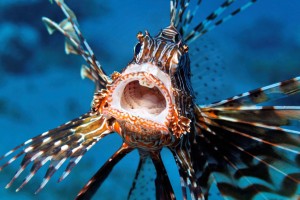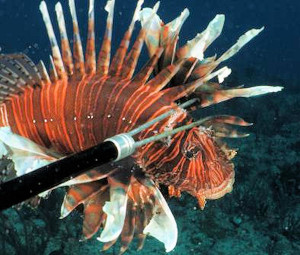 Efforts to tame Florida’s invasive lionfish haven’t worked. Now these venomous fish are eating each other. Though it probably won’t reduce their numbers substantially.
Efforts to tame Florida’s invasive lionfish haven’t worked. Now these venomous fish are eating each other. Though it probably won’t reduce their numbers substantially.
Watch divers and researchers fight the invasive lionfish in Florida’s coastal waters.
By Katie Pyzyk, National Geographic
PUBLISHED JULY 23, 2015
CONCH KEY, Florida—Fisherman Gary Nichols, who has been finding lionfish in his lobster traps off the Florida Keys for years, has noticed something different this year. Lionfish are eating each other.
“When you bring them up from those depths, lionfish spit out what’s in their stomachs. I noticed quite a few of them regurgitating other lionfish. I didn’t even have to gut them to see it because they’re still in their mouths,” Nichols says. “They’re pretty incredible eaters so I’m not really surprised.”
Cannibalism may seem like nature’s way of coping with Florida’s growing lionfish invasion. But it is unlikely to offer a cure.
Visually stunning with their maroon and white stripes and long, fanlike fins, lionfish are considered the most destructive exotic species in marine waters off Florida and the Caribbean. They have voracious appetites and consume dozens of organisms in one feeding. Drastically reducing other fish populations and altering delicate reef ecosystems.
In addition, lionfish can lay up to 30,000 eggs every four days. Their venomous spines leave them with no known predators in Florida waters. [There are photos and videos of sharks and grouper eating them.]
DNA evidence has confirmed that lionfish in Caribbean waters are engaging in cannibalism. Researchers are trying to determine if it’s because the fish is depleting its existing foods, such as gobies and snapper.
Cannibalism Is Rare
Off the Florida Keys, Nichols used to find shrimp and other small invertebrates in his lobster traps. But he has noticed a steep decline. He suspects that lionfish are eating the crustaceans. Because that can’t satisfy them, they are resorting to preying on each other.
Lionfish with voracious appetites have invaded the waters off Florida, posing a risk to delicate reef ecosystems. “I’ve seen a lot bigger lionfish [this year] and I’m seeing lionfish full of lionfish,” he says. “They’re eating all the little stuff up. I think because they’ve eaten up most of their food sources…now they’re eating other lionfish.”
Cannibalism does occur in some species of reef fish, but it is rare, according to marine scientists. A study of stomach contents discovered cannibalism in four of 130 lionfish collected in the Bahamas. Similar results from a study of 157 in Mexico.
Due to a lack of research, it’s unclear if lionfish cannibalism is holding steady or increasing.
“If we saw an increase in cannibalism that could mean that there are so many lionfish that lionfish are controlling themselves. But I don’t think it’s reached that point yet,” says Nova Southeastern University marine researcher Matthew Johnston, who tracks lionfish population trends. “It would be interesting to see over time if there’s an increase. Because I would think that would mean that they’re getting close to their carrying capacity for that particular area.”
Dramatic Toll of Lionfish
Florida’s lionfish threat began off the Atlantic coast in the late 1980s. Experts suspect the invasion started when someone released aquarium lionfish into the wild.
Lionfish don’t throw marine ecosystems out of balance in their native Indo-Pacific region. But in the Atlantic, research shows the rapid increase in lionfish coincided with a 65-percent native fish decline during a two-year period.
“There’s no other known species this effective in the salt water off our coast in the recent years since we’ve been keeping track,” says Amanda Nalley of the FWC.

Click on Photo for Larger View
Florida officials have encouraged divers to spear lionfish to help control their populations. Ocean currents and hurricanes helped lionfish spread from Florida’s Atlantic coast to the Bahamas, throughout the Caribbean Sea and into the Gulf of Mexico.
“We’ve never, ever had an invasive species in the Atlantic go into our Gulf before. This is new territory,” says Lad Akins of Reef Environmental Education Foundation. He co-authored the DNA study that documented lionfish prey upon themselves and three dozen other species in the Bahamas.
In the northern Gulf of Mexico, lionfish feast regularly on more than 40 varieties of reef fish like wrasses, gobies, and commercially valuable vermilion snapper and flounder. They compete for food with snapper. And had “pretty much eaten everything on the artificial reefs and were forced off to forage,” according to Kristen Dahl, a University of South Alabama Ph.D. student.
Lionfish Cookbooks
The threat has prompted efforts to recruit the public to help fight the invasion. Akins’ group wrote a lionfish cookbook and teaches divers how to spear lionfish. Florida lifted catch limits and size restrictions for anyone hunting them. The state agency also held its first Lionfish Removal and Awareness Day in the spring. And launched the Reef Rangers program, which encourages divers to remove lionfish from reefs at least twice a year.
Nichols learned the fish is edible if its venomous spines are removed, so he began selling them to Florida restaurants. Although he’s had success marketing his catch, the market largely is “an untapped resource,” he says.
“I’m not really going for them, I’m going for lobster, but if I’m going to get them, at least it’s worth some money. And it’s doing something environmentally good,” Nichols says.
The species’ spread hasn’t slowed, despite such efforts. Dahl notes that lionfish populations are still growing in areas like the Gulf of Mexico.
“Whatever it is about their system, they’re just ramping up. They keep going up in densities, sizes and weights. It’s pretty crazy,” Dahl says.
Lionfish are native to reefs off Indonesia. Scientists do not understand what controls their populations in the Indo-Pacific, but in waters off Florida and in the Caribbean, they have no predators.
Lionfish densities in parts of the Atlantic are five times greater than in the Indo-Pacific. Scientists haven’t determined what keeps lionfish numbers in check in their native region, but “the controlling factor likely would not even exist in the Atlantic,” Johnston says.
It raises concern that lionfish could spread to the world’s few unaffected areas, such as the Panama Canal and the Mediterranean.
Lionfish haven’t been known to pursue humans. But getting poked by a lionfish spine can cause pain and occasionally nausea or respiratory trouble.
Anglers and researchers have recently observed other lionfish behavior changes, such as inhabiting depths greater than 100 feet. That contradicts the belief that lionfish only are shallow reef dwellers.
“I don’t know if they’re changing or why. It’s pretty rapid evolution, if that’s what’s happening,” Johnston says.
One thing about lionfish is clear: They provide a lesson about how destructive invasive species can be in Florida.
“We had no idea this was going to happen with lionfish. It is way too late to do anything about it,” Johnston says. “We need to learn from this example and not let it happen again.”
Follow Katie Pyzyk on Twitter.
Source: This Beautiful But Destructive Fish Is Resorting to Cannibalism
